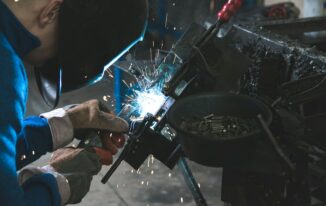Plasma cutting is a game-changer in the world of metal fabrication, slicing through materials like a hot knife through butter. But let’s be real: It’s not all smooth sailing. Sparks fly, heat soars, and there’s a potential for hazards if you’re not careful. That’s why knowing the ins and outs of plasma cutting safety isn’t just a good idea; it’s essential.

In this guide, we will dive deep into the nitty-gritty of creating a safe workspace, understanding the risks, and mastering the techniques that protect you. So, without any further ado, let’s spark up your knowledge and ensure you’re equipped to handle this powerful tool confidently.
Fire Hazard
One of the most hazardous aspects of plasma cutting is the potential for fire. The high temperatures and sparks generated can easily ignite flammable materials.
To prevent this, ensure your workspace is free of any flammable objects. Keep materials like paper, cloth, and certain chemicals far from the plasma cutter. Ideally, maintain a distance of at least 35 feet between the cutter and any flammable items. Additionally, always have a fire extinguisher within reach. If removing all flammable items from the vicinity is impossible, use flame-proof covers to protect the immediate area.
By taking these precautions, you can significantly reduce the risk of fire and ensure a safer working environment.
Intense Light and Radiation
When operating a plasma cutter, protecting your eyes and skin from the intense light and radiation the plasma arc produces is essential. Always wear personal protective equipment (PPE) to shield yourself from these hazards. Face shields are crucial as they protect your head, face, and eyes from debris and sparks.
In addition to a face shield, safety glasses with a shade level of four or five should be worn to protect your eyes from bright arc flashes. Welding gloves are also necessary to safeguard your hands from extreme heat and burns.
It’s important to remember that different cutting techniques may require specific safety gear. For example, many people think about plasma cutting vs laser cutting, assuming they use the same tools, but each method has unique requirements. While both processes need robust PPE to protect against light and heat, the specific type of gear might vary. This is not necessarily the case with other methods like water jet cutting, which involves different hazards and, thus, different protective measures.
So, always evaluate your safety gear based on the specific cutting technique to ensure optimal protection.
Electrocution Hazard
Plasma arc torches are designed to protect operators from electric shock. They turn off automatically if any part becomes loose or if the tip contacts the electrode. However, it is crucial to ensure the plasma cutter is on a non-conductive surface, such as wood or a rubber mat. This surface should be protected against fire and should never be wet, as moisture conducts electricity.
Regularly inspect your equipment for damaged or bare wires and replace any faulty components before use. Wear dry clothing and gloves to prevent electrical shock. Proper grounding and vigilant maintenance are crucial to avoiding these issues.
Toxic Fumes Hazard
During plasma cutting, toxic fumes and gases are produced, much like in other types of welding. Proper ventilation is essential to prevent inhalation of these harmful substances. Use a respirator, especially in confined spaces where ventilation may be limited.
Additionally, consider using a welding fume extractor if airflow is restricted. It’s also wise to refer to safety codes and standards to ensure the correct equipment is used for fume extraction. If you’re cutting coated metals, remove the coating beforehand to limit toxicity.
By providing adequate ventilation and using appropriate respiratory protection, you can safeguard your lungs from harmful fumes.
Keep Your Workspace Organized
A cluttered workspace is an accident waiting to happen. Imagine tripping over a hose or bumping into a pile of scrap metal while holding a plasma torch – not a good scenario! That’s why maintaining a clean and organized workspace is essential for plasma cutting safety.
Regularly clear away debris, scrap metal, and any flammable materials. Ensure that your plasma cutter, hoses, and cables are neatly arranged and do not obstruct your movement. Keep tools and consumables within easy reach, but not in a way that could become a tripping hazard. A well-organized workspace not only promotes safety but also improves efficiency and productivity.
Wrapping Up
Following these safety tips can minimize the risks associated with plasma cutting and ensure a safer work environment. Remember, safety is paramount, and taking the necessary precautions can prevent accidents and injuries.
Stay informed, stay prepared, and always prioritize your safety while working with plasma-cutting equipment.


